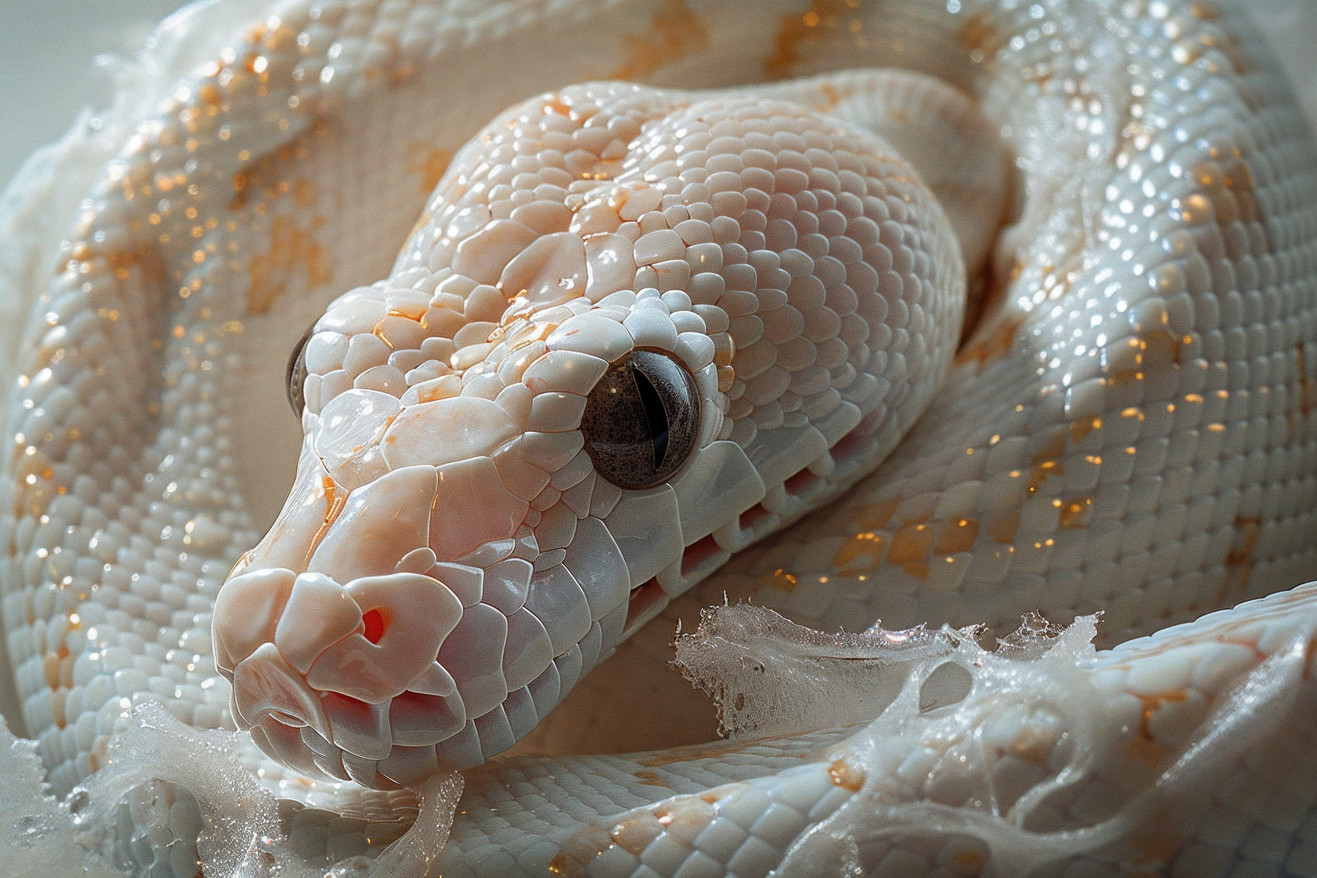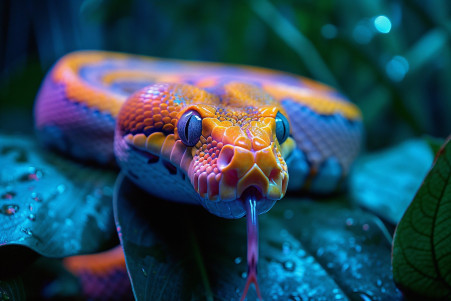How Often Do Snakes Shed? Unraveling the Science Behind Skin Renewal
15 March 2024 • Updated 15 March 2024

Snakes are constantly growing and changing, but how often do they renew their skin? On average, snakes shed their skin two to four times a year, although younger snakes that are still growing tend to shed more often than fully grown adults. The frequency of shedding can also depend on a snake’s diet, health, and the conditions of its environment.
This article will explore a number of biological and herpetological research studies to explain the factors that determine how often snakes shed. By looking at research on growth rates, species-specific behaviors, and the differences between snakes in captivity and the wild, we hope to offer a complete picture of this natural phenomenon. You’ll learn how the details of a snake’s life can impact the frequency of its skin renewal.
How often do snakes shed?
Growth and Age: The Most Important Factors in How Often Snakes Shed
The frequency of snake skin shedding, also known as ecdysis, is directly tied to the snake’s growth rate. This can be most easily observed when comparing juveniles and adults. Juvenile snakes, like humans, grow at a faster rate and therefore shed more frequently—sometimes as often as every two weeks, according to a study published in PMC.
Meanwhile, adult snakes, who have reached a more stable size, shed much less frequently, with an average of perhaps two times a year.
The ball python is an example of this, and one that has been studied in great detail when it comes to shedding. During their juvenile years, ball pythons shed more frequently, about every 4–6 weeks, to keep up with their rapid growth.
A snake’s diet and nutrition also play a big part in skin health and how often they shed. A good diet leads to a faster growth rate, which in turn leads to more frequent shedding to get rid of the skin that’s been outgrown.
This isn’t just true for ball pythons, but is a theme throughout the snake world, where the environment and the availability of food can impact growth and therefore shedding. Knowing this can give you a good idea of a snake’s overall health and how well they’re prepared to face the challenges of their environment.
Shedding the Skin: How the Environment and Seasons Impact Shedding
Snakes are masters of adaptation, and this is no different when it comes to their shedding patterns. Warmer temperatures and higher humidity levels tend to speed up the all-important shedding process. According to WikiVet English, the proper care of snakes involves ensuring that their housing has the right environmental conditions, which will have a big impact on how often they shed.
Seasonal changes also come into play. Many species of snakes tend to shed more often in the warmer months when their metabolisms are higher, allowing them to sync up their shedding with the seasons.
In his paper, Raymond T. Hoser explains that the shedding frequency of snakes in captivity is largely influenced by temperature, humidity, and the quality of their diet. This is in line with their wild counterparts, although the frequency is likely to be different due to the controlled environment.
Habitat is another major factor; snakes in the wild experience a wider range of environmental conditions than those in captivity, which can impact their shedding. For example, environmental factors may cause some species to shed as a way to adapt to their surroundings, allowing them to camouflage themselves against seasonal changes or prepare for periods of increased activity.
This means that people who care for snakes need to be aware of these environmental factors so that they can set up habitats that will support healthy, regular shedding. This is important for ensuring that these fascinating animals are healthy and happy.
Nutrition for Healthy Shedding: How Diet Affects Snake Skin Health
The diet of a snake is also important for maintaining skin health and influencing the shedding cycle. A study published in PMC notes that epidermal lipids are a critical component of the barrier that protects against cutaneous water loss and is therefore important for maintaining the integrity of snake skin. The snake’s diet affects these lipids, and the kind of prey eaten may affect the lipid composition and, in turn, the shedding frequency.
On the other hand, a study in PMC found that although dietary differences in the form of fish and mice affected the lipid composition of the skin in Northern Cottonmouths, it did not significantly affect the snakes’ epidermal lipid content or their shedding frequency. This suggests that while nutrition is important, the relationship between diet and shedding is complex and species-specific and is not just a product of the snake’s recent diet.
The Merck Veterinary Manual suggests that snake owners who want to ensure their pets have healthy shedding should provide a varied diet of high-quality prey. In addition, maintaining a consistent feeding schedule and making sure the prey is well-fed can help ensure a snake’s overall health, including the health of its skin and the frequency of its shedding.
By taking these nutritional variables into account, researchers can investigate the underlying physiological mechanisms that make it possible for snakes to shed their skin successfully.
The Science of Ecdysis: How Snakes Shed Their Skin
Ecdysis is a complex process that is important for a snake’s survival, and it has both physiological and evolutionary implications.
On a molecular level, a study by Joe Baio at Oregon State University found that the process is made possible by the way fatty lipid molecules line up on the snake’s ventral side. According to ScienceDaily, these molecules create an ultra-smooth surface that reduces friction, allowing snakes to move more easily across the ground, which is helpful for both hunting and avoiding predators.
On an evolutionary level, ecdysis is important for sensory perception and protection. As the old skin becomes more worn, it can limit a snake’s ability to sense its environment, so ecdysis is important for maintaining the best sensory acuity. In addition, as noted by Britannica, the new skin is not only brighter but also provides better protection against pathogens and other threats.
The frequency of ecdysis is an evolutionary adaptation that is different for different species and even different individual snakes, and it can be affected by a number of factors including growth, environment, and age.
Research published in Ecology and Evolution by Harry W. Greene found that advanced snakes may have evolved different ecdysis frequencies to maximize their ecological success, which suggests that there is a connection between ecdysis and a number of life history traits.
This constant cycle of renewal is a reflection of a snake’s adaptive response to a variety of environments, and it has led to the question of how these cycles can be used to understand a snake’s health and behavior.
Understanding Snake Behavior: Cues and Consequences of Shedding
As snakes get closer to the shedding process, there are a number of behaviors that are often observed. For example, in their study of brown treesnakes, researchers noted that the snakes’ activity levels decreased and their habitat use changed after feeding because of the energy demands of digestion.
This is similar to the inactivity that snakes exhibit during pre-shedding, when they become less active, likely because their vision is impaired when their eyes become cloudy, a sign that ecdysis is about to occur.
There are also health cues that can be observed, such as an increase in hiding, which is a sign of the snake’s increased vulnerability and need for security during this time. As Pets on Mom notes, the shedding process not only leads to inactivity but it also often leads to a decrease in the snake’s appetite until the shedding cycle is over.
These changes can have a temporary impact on a snake’s hunting success and social behavior. For example, a hunting snake may be less likely to engage in active foraging during the shedding process and may be more likely to use sit-and-wait foraging tactics.
It’s important to understand these behavioral changes in order to ensure the welfare of snakes, as it will help ensure that they are in an environment and being cared for in a way that takes their natural behaviors and needs into account.
By understanding these changes, we can make sure that snakes are in an environment that will help them feel safe and secure during these times.
Shedding: A Metaphor for the Ouroboros and the Power of Renewal
The many factors that impact the shedding process in snakes demonstrate the adaptability and resilience of these animals. The most important factors are growth and age, which lead to more frequent shedding in younger snakes as they grow and less frequent shedding in older snakes as they reach maturity.
Environmental and seasonal factors, including changes in temperature, humidity, and habitat, also impact how often snakes shed, as shown in studies by WikiVet and Raymond T. Hoser.
Another important factor is good nutrition, which helps ensure that snakes can shed regularly and successfully. In addition to these factors, shedding also has a physiological purpose, helping snakes maintain their senses and stay safe.
This shows that shedding has been an evolutionary advantage for snakes as they have adapted to different environments. Finally, the changes in behavior and health that snakes experience during shedding can be used to assess their well-being, which shows the importance of understanding and working with snakes’ shedding cycles in captivity.
In conclusion, shedding is a complex process that is essential to snakes’ development, well-being, and survival. By examining the various factors that influence how often snakes shed, we can improve our understanding and care for these remarkable animals. This, in turn, can foster a stronger connection between snakes and those who study or look after them, illustrating the significant role that shedding plays in the lives of snakes.


